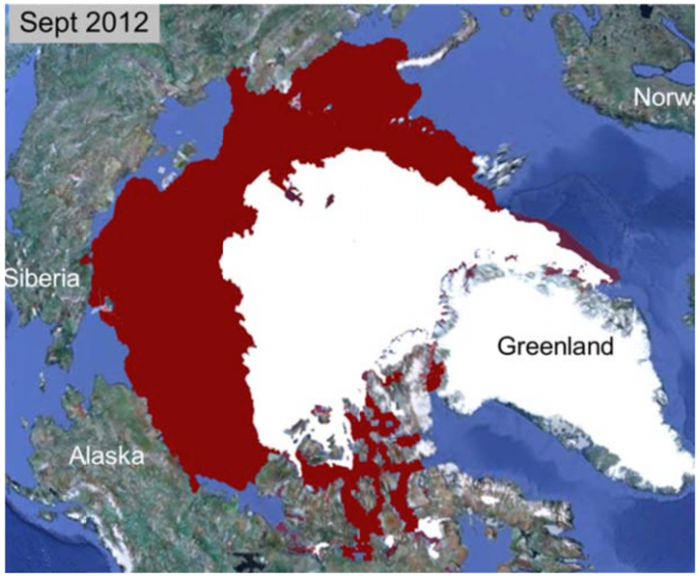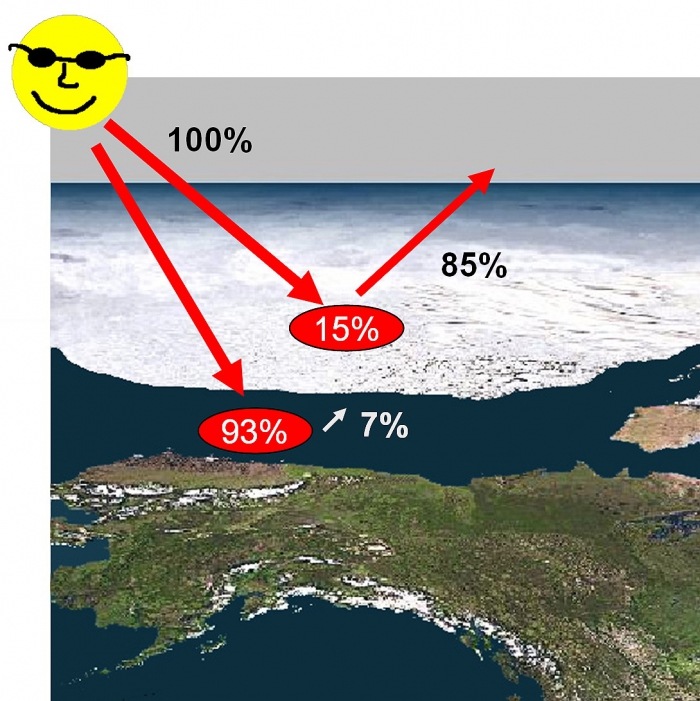![By Donald Perovich [Public domain], via Wikimedia Commons By Donald Perovich [Public domain], via Wikimedia Commons](/files/resize/page/images/25398/ice_station_sheba-crrel-500x288.jpg)
A Frozen Ocean. In the ocean it gets so cold that the ocean freezes forming sea ice, which floats on the surface. During cold temperatures, new ice grows rapidly from open water, growing to one to two meters thick in its first year.
No Sea Level Rise. It is important to remember that sea ice floating in the ocean is already displacing it's weight. Thus, if sea ice melts there is no large change in sea level. However, there may be a minor effect due to changes in water temperature or salinity. Alternatively, the melting of ice sheets and glaciers, which rest on land instead of floating on ocean, contributes major increases to sea level. ">Watch a video.
Expansive, Thin, and Young. The Arctic sea ice cover is huge in areal extent, covering millions of square kilometers, but it is only a thin veneer a few meters thick. It is also young, with about 70% of the ice cover being one year old or less. Only 3% of the ice is older than 4 years. See maps of ice age by area.
It Moves. Sea ice moves in response to winds and ocean currents, often as much as several kilometers per day. Ice motion is governed by a momentum equation. The Arctic-scale motion field is dominated by notable features, including the Beaufort Gyre and the Transpolar Drift.
Indicator of Climate Change. The Arctic sea ice cover is an indicator of climate change. While sea ice covers a large area, climate warming can significantly reduce ice extent because the ice is so thin. Less ice is expected in a warming climate.
Since 1979 satellites have been monitoring the extent of the Arctic sea ice cover. The best time to detect long-term trends is at the end of summer melt in September when the ice reaches its annual minimum. Figure 1 shows the time series of September ice extent. While there is year-to-year variability, a downward trend is unmistakable.

Figure 1. Monthly September ice extent for 1979 to 2016 shows a decline of 13.3% per decade. The September ice extent decreased from 7.8 to 3.4 million square kilometers from 1980 to 2012, a 56% decline. There have been large ice losses around the periphery of the Arctic Basin. See Figure 2.

Figure 2. The spatial distribution of the Arctic sea ice loss between 1980 (red and white) and 2012 (white only). It is hard to comprehend such large numbers. Years ago, the September ice extent covered an area roughly the size of the continental United States. This animation shows the year-to-year change in ice extent and the equivalent changes in the continental United States.
Highly Reflective. Snow covered sea ice reflects about 85% of the sunlight that strikes the surface. Bare melting ice reflects about 65%. By comparison the dark open ocean only reflects about 7% of the incident sunlight. As the ice melts and melt water collects on the surface, features called melt ponds form. Melt ponds reflect between 20 to 50% of the incident sunlight. As the ice disappears completely, the ice is replaced by the dark sunlight- absorbing ocean. This is an extreme contrast as new snow is the best naturally occurring reflector and the ocean is among the worst.
The fraction of the incident sunlight that is reflected is called the albedo (reflected divided by incident).

Pacific Marine Environmental Laboratory (NOAA) Amplifier of Climate Change. Sea ice is an amplifier of climate change through positive feedback mechanisms such as the ice albedo feedback. The ice albedo feedback describes how the loss of sea ice due to warming drastically decreases the albedo of the surface, enabling more heat to enter the ocean, thus increasing sea ice loss. Positive feedbacks are of prime concern from a climate perspective since small changes can be transformed into large impacts.
Large Variability. A defining characteristic of the Arctic sea ice cover is variability. Surface conditions vary from snow-covered ice to bare ice to ponded ice. Ice thickness ranges from thin newly formed ice to deformed ice tens of meters thick. The variability of sea ice evolves over the seasonal cycle as a function of both temperature and dynamics.
Ecosystem Support. The harsh environment of Arctic sea ice is home to a rich marine ecosystem. In spring and late summer there are blooms of ice algae followed by phytoplankton blooms that support a vast and complex food web. The ecosystem includes seals, walruses, polar bears, and migrating whales.
A Barrier. The sea ice cover is a barrier in several contexts. Sea ice inhibits shipping, often necessitating the use of an icebreaker, and thus limits marine access to much of the Arctic. The ice is also a barrier to the exchange of heat and moisture between the atmosphere and the ocean. During the long Arctic winter, the ice insulates the ocean from cold temperatures in the atmosphere. Throughout summer, the ice is a barrier to sunlight entering the ocean to warm the upper layers.
